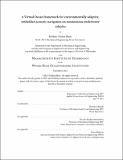A Virtual Ocean framework for environmentally adaptive, embedded acoustic navigation on autonomous underwater vehicles
Author(s)
Bhatt, EeShan Chetan
DownloadThesis PDF (25.97Mb)
Advisor
Schmidt, Henrik
Terms of use
Metadata
Show full item recordAbstract
Autonomous underwater vehicles (AUVs) are an increasingly capable robotic platform, with embedded acoustic sensing to facilitate navigation, communication, and collaboration. The global positioning system (GPS), ubiquitous for air- and terrestrial-based drones, cannot position a submerged AUV. Current methods for acoustic underwater navigation employ a deterministic sound speed to convert recorded travel time into range. In acoustically complex propaganda environments, however, accurate navigation is predicated on how the sound speed structure affects propagation. The Arctic's Beaufort Gyre provides an excellent case study for this relationship via the Beaufort Lens, a recently observed influx of warm Pacific water that forms a widespread yet variable sound speed lens throughout the gyre. At short ranges, the lens intensifies multipath propagation and creates a dramatic shadow zone, deteriorating acoustic communication and navigation performance. The Artic also poses the additional operational challenge of an ice-covered, GPS-denied environment.
This dissertation demonstrates a framework for a physics-based, model-aided, real-time conversion of recorded travel time into range--the first of its kind--which was essential to the successful AUV deployment and recovery in the Beaufort Sea, in March 2020. There are three nominal steps. First, we investigate the spatio-temporal variability of the Beaufort Lens. Second, we design a human-in-the-loop graphical decision-making framework to encode desired sound speed profile information into a lightweight, digital acoustic message for onboard navigation and communication. Lastly, we embed a stochastic, ray-based prediction of the group velocity as a function of extrapolated source and receiver locations. This framework is further validated by transmissions among GPS-aided modem buoys and improved upon to rival GPS accuracy and surpass GPS precision.
The Arctic is one of the most sensitive regions to climate change, and as warmer surface temperatures and shrinking sea ice extent continue to deviate from historical conditions, the region will become more accessible and navigable. Underwater robotic platforms to monitor these environmental changes, along with the inevitable rise in human traffic related to trade, fishing, tourism, and military activity, are paramount to coupling national security with international climate security.
Date issued
2021-09Department
Massachusetts Institute of Technology. Department of Mechanical EngineeringPublisher
Massachusetts Institute of Technology